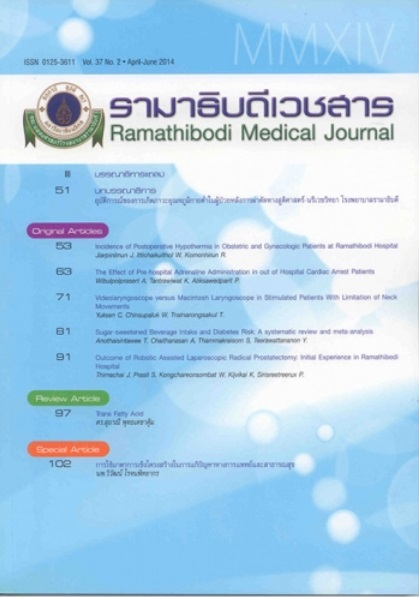อุบัติการณ์ของการเกิดภาวะอุณหภูมิกายต่ำในผู้ป่วยหลังการผ่าตัดทางสูติศาสตร์-นรีเวชวิทยา โรงพยาบาลรามาธิบดี
Keywords:
Core body temperature, Neuraxial blockAbstract
ภาวะอุณหภูมิกายต่ำ (Core body temperature < 36 องศาเซลเซียส) ของผู้ป่วยศัลยกรรมเป็นปัญหาที่ได้รับความสนใจมากในปัจจุบันเนื่องจากมีหลายการศึกษาพบว่า ภาวะอุณหภูมิกายต่ำมีีความสัมพันธ์กับการเสียเลือดและการให้เลือดระหว่างผ่าตัดมากขึ้น เพิ่มอัตราการติดเชื้อของแผลผ่าตัด ผู้ป่วยต้องอยู่ในโรงพยาบาลนานขึ้นและเพิ่มอัตราการเกิดภาวะแทรกซ้อนทางระบบหัวใจและหลอดเลือด จึงมีแนวทางปฏิบัติในการระงับความรู้สึกเพื่อการผ่าตัดให้มีการวัดอุณหภูมิกายเมื่อมีการระงับความรู้สึกแบบทั่วไปเกินกว่า 30 นาที และในการระงับความรู้สึกเฉพาะส่วนสำหรับการผ่าตัดใหญ่ การศึกษาเรื่องภาวะอุณหภูมิกายต่ำหลังผ่าตัดในผู้ป่วยสูตินรีเวชของโรงพยาบาลรามาธิบดีจึงนับเป็นการศึกษาที่ให้ข้อมูลพื้นฐานที่เป็นประโยชน์ในการวางแผนและสนับสนุนให้เกิดการดูแลผู้ป่วยผ่าตัดเพื่อป้องกันการเกิดภาวะอุณหภูมิกายต่ำให้ดียิ่งขึ้นและยังเป็นแรงผลักดันที่ดีในการทำวิจัยในเรื่องสำคัญนี้เพื่อช่วยลดอัตราการเกิดภาวะแทรกซ้อนที่รุนแรงดังกล่าวจากอุณหภูมิกายต่ำของผู้ป่วยยผ่าตัดให้ดียิ่งขึ้นไป
References
Kurz A, Sessler DI, Lenhardt R. Perioperative normothermia to reduce the incidence of surgical wound infection and shorten hospitalization. Study of Wound Infection and Temperature Group. N Eng J Med 1996;334:1209-15.
Schmied H, Kurz A, Sessler DI, Kozek S, Reiter A. Mild hypothermia increase blood loss and transfusion requirements during total hip arthroplasty. Lancet 1996;347:289-92.
Frank SM, Fleisher LA, Breslow MJ, et al. Perioperative maintenance of normohermia reduces the incidence of morbid cardiac events. A randomized clinical trial. JAMA 1997;277:1127-34.
Sessler DI. Temperature monitoring and perioperative thermoregulation. Anesthesiology 2008;109:318-38.
Byrd JR. Practice management: Are you 'actively warming' to PQRI in 2010. ASA article. February 2010 Vol. 74 no. 2
Leslie K, Sessler DI. Perioperative hypothermia in the high-risk surgical patient. Best Pract Res Clin Anaesthesiol 2003;17(4):485-98.
Moslemi-Kebri M, El-Nashar SA, Aletti GD, Cliby WA. Intraoperative hypothermia during cytoreductive surgery for ovarian cancer and perioperative morbidity. Obstet Gynecol 2012;119:590-6.
Downloads
Published
How to Cite
Issue
Section
License
Copyright (c) 2014 By the authors. Licensee RMJ, Faculty of Medicine Ramathibodi Hospital, Mahidol University, Bangkok, Thailand

This work is licensed under a Creative Commons Attribution-NonCommercial-NoDerivatives 4.0 International License.













